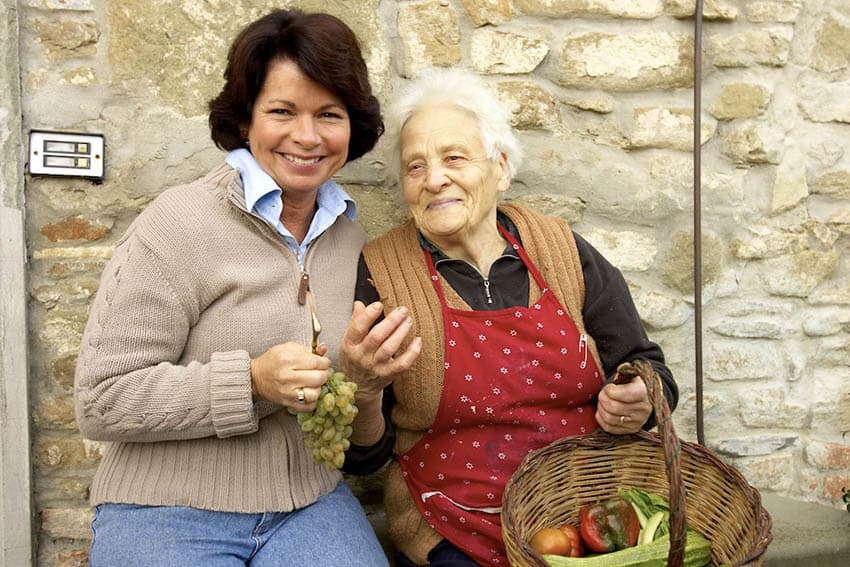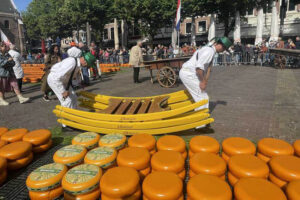Spooky Switzerland: Alien Nightmares and Mystical Savages
By Gary Singh

Unlike some tourists, when I contemplate Switzerland, I don’t think of army knives, watches, the alps, or secret bank accounts. I think of the late psychologist Carl Jung writing about alchemy — transmuting base metals into gold as a metaphor for personal and psychological transformation.
I think of the macabre surrealist H.R. Giger, whose horrific biomechanical nightmarescapes have influenced morbid self-seekers for generations.
I have no use for standardized guides, so before my infiltration of the Swiss countryside, I landed a used copy of Richard and Iona Miller’s The Modern Alchemist: A Guide to Personal Transformation, a work utilizing some Jungian concepts.
World travel should involve continuous transpersonal renovation rather than giddy guidebook-driven sightseeing, so while digesting that particular book, I followed in the footsteps of H.R. Giger, using Jung as the inspiration. Both individuals are worshiped across the globe, but neither is popular in his own country.
Giger, Willing and Gruyeres
One is easily transformed upon entering the H.R. Giger Museum in the medieval village of Gruyères. It sticks out like a decapitated thumb.
Giger, rhyming with meager, is the notorious troublemaker best known for designing the creatures in the 1980 film Alien, for which he won a well-deserved Oscar, but he also creates ghastly airbrush paintings, furniture, sculptures, album covers and graphic designs featuring erotic-occult-fantasy transmogrifications of the most disturbing sort. He says he paints whatever scares him.
Gruyères, with a population of about 1700, is a place that exists almost entirely for tourists, as thousands are regularly bussed in for the famous castle and cheese of the same name. No one departs without dining at the obligatory fondue restaurant. The main village road is just a few blocks long.

Over time, Giger fell in love with the area, calling it a “beautiful cheek of Switzerland.” In 1998, to the explosive annoyance of the locals, he acquired an old stone fortress, the Château St. Germain, and converted it into a permanent three-story museum of his work.
Two levels of the building highlight the entire span of his career, including wall-size airbrushes of wicked Baphomet imagery, Lovecraftian horror scenes, and bald women whose nether regions morph into weapons.
Also present in the museum are the actual latex creatures from Alien, a wall of Giger tattoo photos and — behind the 18-and-over curtain — “Penis Landscape,” the infamous artwork that got Jello Biafra of the Dead Kennedys arrested and tried on obscenity charges.
The top floor showcases other artists that Giger has personally collected and the gift shop on the street level features limited edition Giger posters, t-shirts, books, and even bottles of absinthe with Giger’s labels. Commendably, the entire facility is staffed by Swiss goth hotties.

Mia Anima
“Most people travel to Gruyères for the castle and the cheese factory,” says Aurore Sierro, one of the Museum’s tour guides. “And when they come in here, they get disgusted.”
With an angelic French accent, she schools me on many aspects of Giger’s life: His birth was unusually long and traumatic, with the doctor needing forceps to get him out of the womb; detractors blamed him for his first wife’s depression and suicide; and as a teenager, he set his dad’s pharmacy on fire by trying to melt lead. (Read: alchemy, transformation.)
Ascending a spiral wooden staircase, we eventually arrive at a room featuring huge airbrushes of The Spell, I, II, III, and IV — one on each wall. Spell III includes Giger’s version of the Baphomet symbol at its center, complete with the Caduceus — two snakes coiling into a figure 8 around a shaft. Baphomet and the snakes represent male and female energy or dark/light polarity.
“But he is definitely a Swiss artist,” Sierro enthuses, pointing out traditional Swiss doily textures Giger stenciled on the skins of the snakes in Spell III. “He also painted aliens eating fondue.”
Minutes later, in a different room, she points out another famous Giger painting, Anima Mia, an otherwordly nightmarescape of flowing interconnected biomechanoids. Mia was Giger’s second wife and inspiration while he created this particular work.
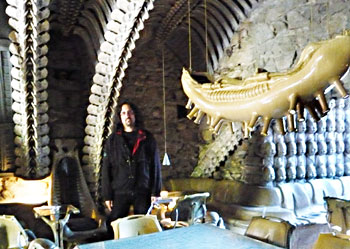
The title is a play on words: Anima means “soul” and is also a Jungian concept representing the unconscious feminine aspect of the male psyche. By sheer synchronicity — a Jungian term — I had just finished Chapter 3 of The Modern Alchemist, titled “Anima,” while on the airplane. My own inner feminine slowly began to emerge.
Life After Birth
And the transformation didn’t stop there. Outside on the cobblestone pathway, some tourists paused to have their photos taken in front of the 500lb cast aluminum Birth Machine sculpture, instead of actually visiting the museum itself.
The massive work is two meters high and features mechanical babies in place of the bullets inside a revolver. The piece is one of many where Giger explores the lifelong psychological effects of a traumatic birth.
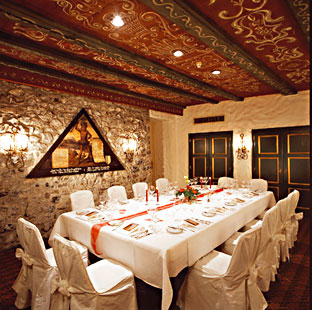
Across the path from the museum, in the same building as an old folks’ home, sits the Giger Bar, a cavernous environment featuring concrete vertebrae ceilings, dead babies and biomechanical furniture. Upon entry, one is immediately transported to another, more mutated world.
In the daytime, the bar is frequented by oldtimers from the retirement facility who, along with their walkers, meander in for glasses of wine. A sign on the wall advertises “Coffee sans alkool,” so I guess sober folks are also welcome.
In order to finish the infiltration of specific Giger places, I decided to eventually make my way to the town of Chur, Giger’s birthplace and the location of another Giger Bar. But a temporary rest stop was necessary, and the city of Lucerne provided another synchronicity. More hidden connections started to emerge from my collective unconscious.
Wild in the Streets
In Lucerne, I found myself at the Hotel Wilden Mann (Wild Man). Turns out Jung also originally provided some of the foundations for the mythopoetic “Wild Man” men’s movement, which tries to recapture some of the fierceness of masculinity.
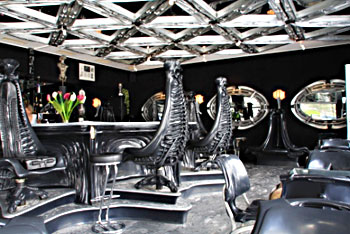
The imagery of the Wild Man figure, the mystical savage, is intertwined with Lucerne’s history, and he is the symbol of untamed strength and resistance to all conventions. I like the sound of that.
Everyone in Lucerne knows the Wild Man myth, and in the hotel, the mid-level salon area features numerous mystical and symbolic medieval drawings on the walls, including Tarot cards, although most won’t notice.
In fact, it seemed like the longer I remained in Switzerland, the more mystical everything seemed to become. Things began to connect in unexplainable ways — Jung, alchemy, transformation, Giger, male/female polarity, etc.
And upon reaching Chur, (pronounced KOOR), a small town pretty much off the radar of most travelers, everything came to a transformative conclusion, although it might be years before I figure out what it all means.
Giger grew up at 17 Storchengasse, which means Stork Street: Another baby connotation. I stood there looking up at the building, which now boasts a bright yellow facade with a women’s cosmetic shop on the ground level: The closing irony of it all, I suppose.
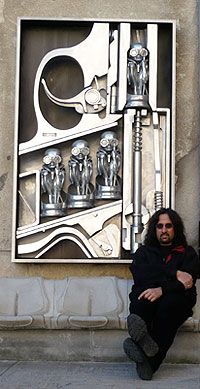 Gary Singh is a freelance journalist who surfaces most often in San Jose, California.
Gary Singh is a freelance journalist who surfaces most often in San Jose, California.
- The Wild Mississippi: 2340 Miles Across Ten States - April 8, 2024
- Exploring the Floating Villages of Tonle’ Sap Lake - April 3, 2024
- Woman Traveling Solo on Turkish Buses - March 27, 2024


